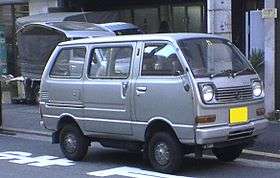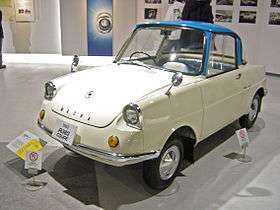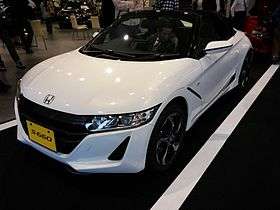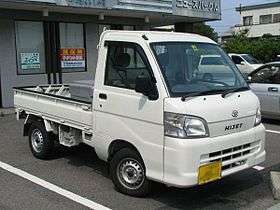Kei car


Kei car, K-car, or kei jidōsha (軽自動車, lit. "light automobile") (pronounced [keːdʑidoːɕa]), is a Japanese category of small vehicles, including passenger cars (kei cars or kei-class cars), microvans, and pickup trucks (kei trucks or kei-class trucks). They are designed to comply with Japanese government tax and insurance regulations, and in most rural areas are exempted from the requirement to certify that adequate parking is available for the vehicle.[1][2][3] This especially advantaged class of cars was developed to popularize motorization in the postwar era. While successful in Japan, the genre is generally too specialized and too small to be profitable in export markets.[4]
Description
The cars feature yellow license plates, earning them the name "yellow-plate cars" (black numbers on yellow background for private use and yellow numbers on black background for commercial use) in English-speaking circles.[2][3] Because regulations only restrict physical size and engine displacement (and latterly outright power), manufacturers have been able to introduce many advanced technologies to the class. As a result, kei cars are often available with forced-induction engines, automatic and CV transmissions, front-, rear-, and four-wheel drive, air conditioning, GPS, and many other features.[3]
Daihatsu, Honda, Mitsubishi, and Suzuki all manufacture kei cars, while Nissan sells badge-engineered Mitsubishi and Suzuki models,[5] Mazda offers badge-engineered Suzuki models, and Toyota and Subaru offer badge-engineered Daihatsu models. German brand Smart offered a kei version of its Fortwo called the Smart K in Japan at Yanase dealerships from 2001 to 2004 with specially developed rear fenders, reduced tire dimensions and track width, to conform to kei car standards,[6] though ultimately the model sold the fewest examples of a kei car when it was marketed.[3]
History
360-cc era (1949–1975)
These standards originated in the times following the end of the Second World War, when most Japanese could not afford a full-sized car, yet had enough to buy a motorcycle. To promote the growth of the car industry, as well as to offer an alternative delivery method to small business and shop owners, kei car standards were created.[1] Originally limited to a mere 150 cc (100 cc for two-strokes) in 1949, dimensions and engine size limitations were gradually increased (in 1950, 1951, and 1955) to tempt more manufacturers to produce kei cars. With the 1955 change to 360 cc as the upper limit for two-strokes, as well as four-strokes, the class really began taking off, with cars from Suzuki (Suzulight) and then Subaru 360, the first mass produced kei car,[7] finally able to fill people's need for basic transportation without being too severely compromised. In 1955, the Japanese Ministry of International Trade and Industry also set forth goals to develop a "national car" that was larger than kei cars produced at the time. This goal influenced Japanese automobile manufacturers to determine how best to focus their product development efforts for the smaller kei cars, or the larger "national car".
The class then went through a period of ever increasing sophistication,[8] with an automatic transmission appearing in the Honda N360 in August 1968, with front disc brakes becoming available on a number of sporting kei cars, beginning with the Honda Z GS of January 1970.[9] Power outputs also kept climbing, reaching a peak in the 40 PS (29 kW; 39 hp) Daihatsu Fellow Max SS of July 1970.[10] Sales increased steadily, reaching a peak of 750,000 in 1970. Throughout the 1970s, the government kept whittling away at the benefits offered to kei vehicles, which combined with ever stricter emissions standards to lower sales drastically through the first half of the decade.[8] Honda and Mazda withdrew from the contracting passenger kei car market, in 1974 and 1976, respectively, although they both maintained a limited offering of commercial vehicles.
Until 31 December 1974, kei cars used smaller license plates than regular cars (230 × 125 mm). As of 1975, kei cars received the medium-sized standard plates (330 × 165 mm). To set them apart from regular-sized cars (not kei), the plates were now yellow and black rather than white and green.
550-cc era (1976–1990)

Sales had been steadily declining, reaching a low-water mark of 150,000 passenger cars in 1975, 80% less than 1970 sales. Many were beginning to doubt the continued existence of the kei car, with both Honda and Mazda withdrawing in the middle of the '70s.[11]
The even stricter emissions standards which were to be introduced in 1975 as part of a staggered program of cleaning the air proved problematic for kei car manufacturers.[n 1] This was particularly hard for Daihatsu and Suzuki, which focused on two-stroke engines. Tiny Suzuki was worse off, with the company's entire production consisting of two-stroke kei cars.[13] Daihatsu, though, had both the engineering backing and powerful connections of their large owner, Toyota, to aid them in meeting the new requirements. All manufacturers of kei cars were clamoring for relaxing the dimension conditions, claiming that the emissions standards could not be met with a functional 360-cc engine (though Subaru's SEEC-T-equipped Rex proved it possible). In the end, the Japanese legislature relented, increasing the overall length and width restrictions by 200 mm and 100 mm, respectively. Engine size was increased to 550 cc, taking effect from January 1, 1976.[13] The new standards were announced on 26 August 1975, leaving very little time for manufacturers to update their offerings.[14]
Most manufacturers were somewhat surprised by the decision; having expected a 500-cc limit, they had already developed new engines to fit such restrictions. These new engines were quickly introduced, usually mounted within widened bodies of existing models.[11] These interim versions (with displacements ranging between 443 and 490 cc) were "feelers", developed to see if indeed a continued market existed for the kei car.[11] As sales improved, they only lasted for a model year or so until manufacturers had the time to develop "full-sized" engines. Only Daihatsu managed to avoid developing transitional engine versions which did not take full advantage of the new regulations. Kei car sales remained stagnant, however; while combined passenger and commercial kei car sales reached 700,000 for the first time since 1974,[12] the small cars still lost market share in a quickly growing market.
As the vehicles became better and more capable, another benefit appeared, as exports increased considerably. In particular, export sales of trucks increased, while kei passenger car exports increased at a lower rate. In 1976, exports of kei vehicles were 74,633 (up 171% year-on-year), despite exports of passenger kei cars decreasing.[15] In 1980, another record year occurred as exports climbed 80.3% (to 94,301 units), of which 77.6% were microtrucks.[16] Nearly 17% of exports went to Europe, dwarfed by Chile which took nearly a quarter of the exported keis.[16] In a tough economy, economic cars sold well and 1981 marked another banner year as Japanese midget car sales reached their highest since the 1970 record (at 1,229,809 units for cars and commercials).[17] As the 1980s progressed, kei cars became increasingly refined, losing their utilitarian origins as Japanese customers became ever better off. All kinds of technical improvements, from four-wheel drive to turbochargers to air conditioning began appearing in them.
660-cc era (1990–present)
In March 1990, new standards were again introduced. An extra 110 cc were now allowed in a slightly larger (100-mm longer) bodyshell. These changes came at a time when the Japanese economy was booming, so all manufacturers quickly developed new models to suit. The only 550-cc model to continue to be available for a while was the Mitsubishi Minica Dangan, which was only upsized five months later.[18] As a response to ever increasing power, a limit of 64 PS (47 kW; 63 hp) was also added. Since 64 PS happened to be the highest outputs to have been reached at the time, reasons for this number to be selected are unknown.
The regulation of horsepower has been suggested to be due to the fitment of turbochargers and superchargers to these tiny engines during the late 1980s to cope with the lack of horsepower and torque. However, the installation of turbochargers and superchargers also had a benefit in that fuel efficiency increased, thereby reducing tailpipe emissions, which are also taxed, while the installation of turbos and superchargers made the vehicles very fast and nimble relative to their size. Engine technology is also shared with sport bikes, which are designed for rider enjoyment, and less so on fuel economy.
Electric kei cars (2009–present)
Mitsubishi Motors introduced an electric kei car in 2009 to fleet purchasers and in 2010 to the general public. The car in Japan is called the i-MiEV, an acronym for Mitsubishi innovative Electric Vehicle. The i-MiEV uses a 63-hp permament-magnet motor. Current models charge overnight in 14 hours from home 110-volt mains, or in 30 minutes from quick-charging stations installed at fleet locations. The range using the U.S. EPA testing routine is 62 miles, 99 miles using the Japanese Transport Ministry's testing routine designed for Japanese conditions.
History of regulations
| Date | Maximum length | Maximum width | Maximum height | Maximum displacement | Maximum power | |
|---|---|---|---|---|---|---|
| four-stroke | two-stroke | |||||
| 8 July 1949 | 2.8 m (9.2 ft) | 1 m (3.3 ft) | 2 m (6.6 ft) | 150 cc | 100 cc | N/A |
| 26 July 1950 | 3 m (9.8 ft) | 1.3 m (4.3 ft) | 300 cc | 200 cc | ||
| 16 August 1951 | 360 cc | 240 cc | ||||
| 4 April 1955 | 360 cc | |||||
| 1 January 1976 | 3.2 m (10.5 ft) | 1.4 m (4.6 ft) | 550 cc | |||
| 1 March 1990 | 3.3 m (10.8 ft) | 660 cc | 47 kW (64 PS; 63 hp) | |||
| 1 October 1998 | 3.4 m (11.2 ft) | 1.48 m (4.9 ft) | ||||
Present day
Starting in 2011, Toyota Motor Corp launched its first minicar, the Pixis Space, a rebadged Daihatsu Move. It is expected to increase competition in the minicar sector.[21] Currently, Nissan Motors is in partnership with Mitsubishi Motors, which produces the minicars for Nissan called the Nissan Otti, while Honda's minicar sales total around a quarter of its overall sales.[21]
Taxation
- Vehicle excise tax
- Taxable amount is 3% of the purchase price, compared to 5% for a larger car
- Automobile weight tax
- The amount is ¥13,200 and ¥8,800 for a three- and two-year period, respectively, as compared to the ¥18,900 and ¥12,600 charged for larger size passenger cars. The savings are thus more than 30% in both cases. This weight tax is paid after the vehicle has passed its safety inspection.
- Automobile liability insurance (compulsory insurance) premiums
- A 24-month insurance contract typically costs ¥18,980 at the time of registration, versus ¥22,470 for a larger car.
- Annual road tax
- Tax is based on the engine's displacement.
Due to the popularity of "light cars", a tax was placed on the size of these vehicles called the Light Motor Vehicle Tax. The amount charged for the size of "passenger cars" (the largest of the three classifications recognized in Japan) is ¥29,500, with passenger cars and trucks with a load-carrying capacity of 1,000 kg or more at ¥13,200. The car tax on "light cars" below 1,000 cc is ¥7,200, or ¥4,000 for commercial vehicles (some local governments may charge more based on local regulations).
Gallery
Classic
After World War II, the kei car was born as the public car. The engineers of the erstwhile Nakajima Aircraft Company developed the first truly successful kei car, the Subaru 360.
 Subaru 360 (1958–1970)
Subaru 360 (1958–1970) Mazda R360 (1960–1969)
Mazda R360 (1960–1969)- Honda N360 (1967–1972)
- Honda Life (1972–1974)
Sport
The kei sports car was born by the "bubble boom" in the latter years of the 1980s, although a few sporty iterations such as the Fronte Coupé, Honda Z and Minica Skipper had appeared in the early '70s. Japanese manufacturers have introduced updated sports car in this segment, called the Honda S660 and the Daihatsu Copen recently.
- Honda Beat (1991–1996)
 Honda S660 (2015- )
Honda S660 (2015- )- Daihatsu Copen (2002–2012)
 Daihatsu Copen Robe (2014- )
Daihatsu Copen Robe (2014- ) Daihatsu Copen Cero (2015 - )
Daihatsu Copen Cero (2015 - ) Suzuki Cappuccino (1991–1998)
Suzuki Cappuccino (1991–1998)- Suzuki Alto Works (1987-2000, 2015- )
- Autozam AZ-1 (1993–1995)
Present
The engine capacity had been expanded to 660 cc (in 1990) to aid high-speed performance and the increased weight of new safety equipment. Ever tighter safety regulations have also necessitated a slightly larger body, since 1998. Most of the vehicles sold currently are built as what is called a "tall boy" or "tall wagon" appearance, using four doors, a one-piece hatchback, and expanded head room.
Commercial vehicle
Many kei trucks (keitora) and microvans are used in Japan. The price of many of them is ¥1,000,000 or less.
 Classic 360-cc light van (late '60's Subaru Sambar)
Classic 360-cc light van (late '60's Subaru Sambar)
- Suzuki Jimny, classified as a truck in Japan
References
- 1 2 Nunn, Peter (January–February 2005). "Minicars: Cheap and Cheerful". JAMA. Retrieved 2012-05-10.
- 1 2 "Owning a Car in Japan", ALTs in Sendai (via Internet Archive)
- 1 2 3 4 "Small Things in Good Packages", Jerry Garrett, New York Times, November 25, 2007
- ↑ Rees, p. 79
- ↑ "Nissan Adds Third Minicar to its Lineup in Japan", Edmunds.com, June 6, 2005
- ↑ "THE 37th TOKYO MOTOR SHOW". Japan Automobile Manufactures Association. Retrieved 11 November 2011.
- ↑ http://blog.autorec.co.jp/2015/10/kei-jidosha.html
- 1 2 Rees, p. 78
- ↑ Nippon Kei Car Memorial, p. 79
- ↑ Nippon Kei Car Memorial, p. 75
- 1 2 3 Yamaguchi, Jack K. (1977), "The Year of the Third Power", World Cars 1977, Pelham, NY: The Automobile Club of Italy/Herald Books: 56, ISBN 0-910714-09-6
- 1 2 Yamaguchi, Jack K. (1979), Lösch, Annamaria, ed., "The Year of Uncertainty?", World Cars 1979, Pelham, NY: The Automobile Club of Italy/Herald Books: 61, ISBN 0-910714-11-8
- 1 2 Yamaguchi, Jack K. (1976), "Japan: Reluctant Number One", World Cars 1976, Bronxville, NY: L'Editrice dell'Automobile LEA/Herald Books: 56, ISBN 0-910714-08-8
- ↑ Nippon Kei Car Memorial, p. 91
- ↑ "Japanese Motor Vehicles Guide Book, Volume 25". 自動車ガイドブック [Japanese Motor Vehicles Guide Book] (in Japanese). Japan: Japan Automobile Manufacturers Association. 25: 334. 1978-10-10. 0053-780025-3400.
- 1 2 "Midget car exports in 1980 hit record". Nihon Keizai Shimbun. Tokyo: 7. 1981-02-24.
- ↑ "Midget car sales swell 21%". Nihon Keizai Shimbun. Tokyo: 7. 1982-01-19.
- ↑ "Goo-net カタログ: 三菱 ミニカ(MINICA)のグレード一覧: 1990年8月" [Goo-net Catalog: Mitsubishi Minica, 1990.08] (in Japanese). Goo-net. Retrieved 2011-10-21.
- ↑ Martin, Schaefers. "History of Mitsubishi Kei Jidosha". Far East Auto Literature. Retrieved 29 November 2016.
- ↑ "道路運送車両法". 一般財団法人 自動車検査登録情報協会. 一般財団法人 自動車検査登録情報協会. Retrieved 29 November 2016.
- 1 2 "Toyota adds first minicar to Japan lineup". japantoday.com. Japan Today. Retrieved 27 September 2011.
Notes
Further reading
- 360cc: Nippon 軽自動車 Memorial 1950→1975 [Nippon Kei Car Memorial 1950–1975] (in Japanese). Tokyo: Yaesu Publishing. 2007. ISBN 978-4-86144-083-0.
- Rees, Chris (1995). Microcar Mania. Minster Lovell & New Yatt, Oxfordshire, UK: Bookmarque Publishing. ISBN 1-870519-18-3.
External links
| Wikimedia Commons has media related to Kei cars. |
- History of regulations
- (Japanese) 全国軽自動車協会連合会



